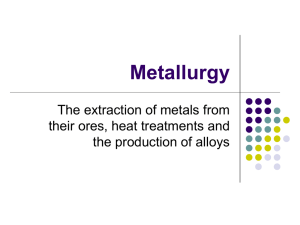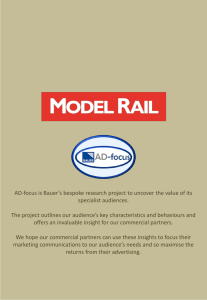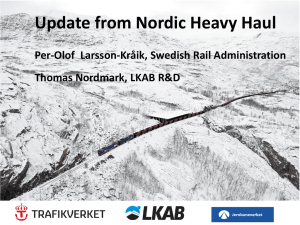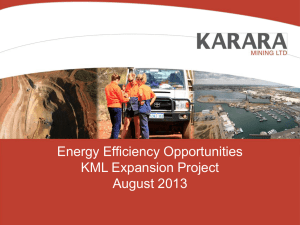Improvement in the Transport Infrastructure for exporting bulk
advertisement
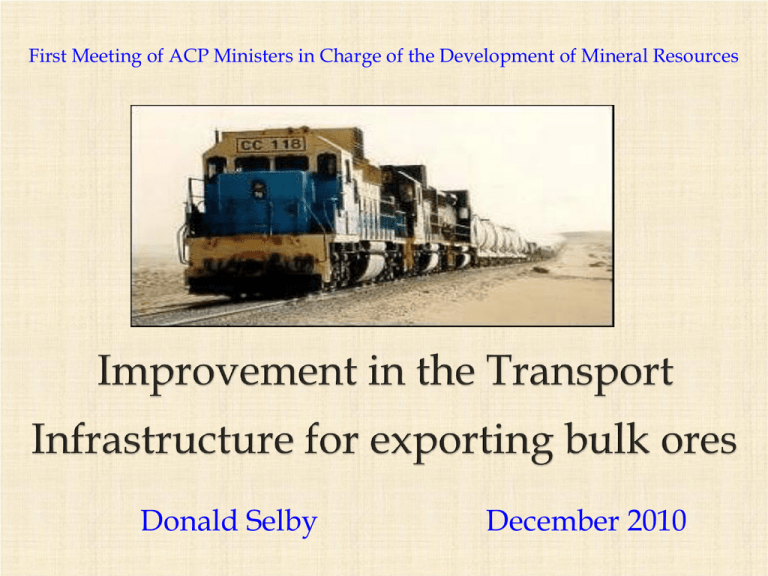
First Meeting of ACP Ministers in Charge of the Development of Mineral Resources Donald Selby December 2010 Introduction Rail ideally suited to transporting bulk ores from the mine head to port and the world market Low operating costs particularly over long distances and volume capacity Mine developments are often constrained because of the lack of an operating railway to the coast Existing networks often in disrepair and not performing Rehabilitation and new construction expensive Despite the costs, rail undergoing a resurgence around the world 2 Introduction Incentives can stimulate investment Public Private Partnerships (PPPs) have changed the face of infrastructure development Offers a means of rehabilitating existing systems and/or constructing new lines and port facilities to support the mining sector Various models suited to rail development BOOT, Concessioning, etc Private sector require adequate return! Need serious planning to be effective 3 Mining Railways Consider a number of examples from West Africa of Mineral railways with different gauges, ownership structure and operating conditions. Bauxite in Guinea Manganese & Bauxite in Ghana Iron Ore in Mauritania 4 Guinea 1086 kilometre network, four lines with a mix of gauges and ownership structures. 5 Guinea Line Gauge Ownership Ore Condition 130km Sangaredi to Kamar Standard CBG Mining Joint venture (Government 49%) Bauxite 12MT Operating 662km Kankan Conakry Metre State Railway Co ONCFG General Needs rehabilitation 143km FriaConakry Metre Mining Co Rus Al Bauxite 1MT Operating 105km KindiaConakry Standard State Mining Co SBK Bauxite 1.2MT Operating 6 Ghana Western Line network: Takoradi port to Kumasi 267km and Dunwar to Awaso branch 73km. Flow Gauge Ownership Ore Condition Nsuta – Takoradi Cape (narrow) State owned GRC Manganese Potential 1-1.5 MT Not being used Awaso Takoradi Cape State owned GRC Bauxite Potential 1-2 MT Minimal traffic 7 Mauritania Line Gauge Ownership Ore Condition 700km Zouerate - Nouadhibou Standard State owned Mining Company SNIM Iron ore 17MT Operating Operates some of the longest and heaviest trains in the world – 2.5km long, 3-4 locomotives & 200 wagons carrying 84 tonnes of ore 8 Mining Rail Projects •Iron Ore in Sierra Leone – Africa Minerals Tonkolili Resource Narrow gauge 76km rehabilitation & 126km new construction. 20-35m tonnes US$1.5- 2m 9 Mining Rail Projects • Coal in Mozambique – Vale, Moatize coalfield 11m tonnes Coking coal & coal to Beira on the refurbished Sena line & Nacala via a new link through Malawi US$1.3m • Iron ore in Guinea - Simandou Mountains. Number of project, Vale, Rio Tinto/Chinese Potential new port in Liberia US$5-8 billion • Phosphates in Mauritania - Bofal deposits. New line US$600m • China important partner in mine & railway development projects everywhere. 10 Stimulating Investment in Railway Infrastructure Railway and port rehabilitation and new construction expensive New railway US$1.5-5m per km (reasonable road US$1m) Worldwide Rail infrastructure PPP projects 1985 – 2004 over US$150 billion. Concessions, BOOT, etc - need for adequate return! Incentive for private investment: land provision, port facilities, rail and mining concessions and/or extensions, tax incentives, traffic guarantees, etc 11 Alice Springs - Darwin 12 Alice Springs - Darwin Lines New Construction: Alice Springs to Darwin 1420km Standard gauge, single track Existing line: Tarcoola – Alice Springs 824km Standard gauge, single track Ownership •Built by Consortium Asia Pacific Transport – Freightlink (Kellogg Brown & Root) •Bought by Genesee & Wyoming earlier this year Ores •Manganese 800km to Darwin •Iron Ore 210km to Darwin •Cooper-gold concentrate 2000km to Darwin Condition/ comments •Cost A$1.2 billion (govt $400m & existing line) •50 year concession •Very successful operationally, but failed to meet debt repayments •Runs 1800m trains with 4000 tonne trailing loads 13 PPP Pros & Cons PROS CONS DELIVERS FUNDS WHERE CONSTRAINTS RESTRICT PUBLIC SECTOR INVESTMENT –FASTER IMPLEMENTATION BENEFITS FROM PRIVATE SECTOR MANAGEMENT, COMMERCIAL SKILLS & ACUMEN TRANSFERS RISK TO THE PARTIES BETTER EQUIPPED TO MANAGE THEM FINANCING COSTS HIGHER FOCUSES ON OUTPUT – SERVICES PROVIDED NOT THE ASSETS DEPLOYED. PERFORMANCED BASED EXPERIENCE SUGGESTS PPPs MORE LIKELY TO BE FINISHED ON TIME & ON BUDGET ENABLES PUBLIC SECTOR TO CONCENTRATE ON CORE BUSINESS LOSS OF CONTROL TO THIRD PARTIES HIGHER TRANSACTION COSTS/PROCESS TAKES LONGER REQUIRES EFFECTIVE POST CONTRACT MANAGEMENT & ADMINISTRATION TO MONITOR PERFORMANCE 14 Conclusion Acceleration of Infrastructure provision-PPPs enable governments to benefit from Private sector management expertise and funding to undertake projects that would otherwise not have been completed a Governments are encouraged to consider them seriously as an option Involves serious capacity building and planning to set up a realistic PPP framework Coupled with incentives to encourage investment can lead to an improvement in the Transport infrastructure for exporting bulk ores. 15 Thank You! D F Selby © 2010 selbycons@clara.net 16


